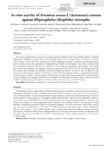Use este identificador para citar ou linkar para este item:
http://www.alice.cnptia.embrapa.br/alice/handle/doc/889463Registro completo de metadados
| Campo DC | Valor | Idioma |
|---|---|---|
| dc.contributor.author | CHAGAS, A. C. de S. | pt_BR |
| dc.contributor.author | GEORGETTI, C. S. | pt_BR |
| dc.contributor.author | CARVALHO, C. O. de | pt_BR |
| dc.contributor.author | OLIVEIRA, M. C. de S. | pt_BR |
| dc.contributor.author | RODRIGUES, R. A. | pt_BR |
| dc.contributor.author | FOGLIO, M. A. | pt_BR |
| dc.contributor.author | MAGALHÃES, P. M. DE | pt_BR |
| dc.date.accessioned | 2011-05-24T11:11:11Z | pt_BR |
| dc.date.available | 2011-05-24T11:11:11Z | pt_BR |
| dc.date.created | 2011-05-24 | pt_BR |
| dc.date.issued | 2011 | pt_BR |
| dc.identifier.citation | Revista Brasileira de Parasitologia e Veterinária, Jaboticabal, v. 20, n. 1, p. 31-35, jan.-mar. 2011. | pt_BR |
| dc.identifier.uri | http://www.alice.cnptia.embrapa.br/alice/handle/doc/889463 | pt_BR |
| dc.description | The activity of plant extracts on parasites may indicate groups of substances that are potentially useful for controlling Rhipicephalus (Boophilus) microplus. The aim of the present study was to investigate the in vitro action of Artemisia annua extracts on this tick. The concentrations of the sesquiterpene lactones artemisinin and deoxyartemisinin present in plant extracts were quantified via high-performance liquid chromatography. Four extracts produced from the concentrated crude extract (CCE) were evaluated on larvae using the impregnated paper method, with readings after 24 hours of incubation. The engorged females were immersed in the CCE and in its four derived extracts for five minutes, with incubation for subsequent analysis of biological parameters. The extracts were not effective on the larvae at the concentrations tested (3.1 to 50 mg.mL-1). The CCE showed greater efficacy on engorged females (EC50 of 130.6 mg.mL-1 and EC90 of 302.9 mg.mL-1) than did the derived extracts. These results tend to confirm that the action of artemisinin on engorged females of R.(B.) microplus is conditional to their blood intake. In this case, in vitro methods would be inadequate for effective evaluation of the action of A. annua on R. (B.) microplus. | eng |
| dc.language.iso | eng | pt_BR |
| dc.rights | openAccess | pt_BR |
| dc.subject | Artemisinina | pt_BR |
| dc.subject | Controle | pt_BR |
| dc.subject | R (B) microplus Artemisia annua | pt_BR |
| dc.title | In vitro activity of Artemisia annua L (Asteraceae) extracts against Rhipicephalus (Boophilus) microplus. | pt_BR |
| dc.type | Artigo de periódico | pt_BR |
| dc.date.updated | 2012-05-04T11:11:11Z | pt_BR |
| dc.subject.thesagro | Carrapato | pt_BR |
| dc.subject.thesagro | Fitoterapia | pt_BR |
| riaa.ainfo.id | 889463 | pt_BR |
| riaa.ainfo.lastupdate | 2012-05-04 | pt_BR |
| dc.identifier.doi | https://doi.org/10.1590/S1984-29612011000100007 | eng |
| dc.contributor.institution | ANA CAROLINA DE SOUZA CHAGAS, CPPSE | pt_BR |
| dc.contributor.institution | CYNTHIA SANCHES GEORGETTI, UNICEP/SÃO CARLOS, SP | eng |
| dc.contributor.institution | CAMILA O. DE CARVALHO, UNESP/JABOTICABAL | eng |
| dc.contributor.institution | MARCIA CRISTINA DE SENA OLIVEIRA, CPPSE | eng |
| dc.contributor.institution | RODNEY ALEXANDRE RODRIGUES, UNICAMP/CAMPINAS | eng |
| dc.contributor.institution | MARY ANN GOGLIO, UNICAMP/CAMPINAS | eng |
| dc.contributor.institution | PEDRO MELILLO MAGALHÃES DE, UNICAMP/CAMPINAS. | eng |
| Aparece nas coleções: | Artigo em periódico indexado (CPPSE)  | |
Arquivos associados a este item:
| Arquivo | Descrição | Tamanho | Formato | |
|---|---|---|---|---|
| 6Finalizadv20n12001151.pdf | 289,54 kB | Adobe PDF |  Visualizar/Abrir |









